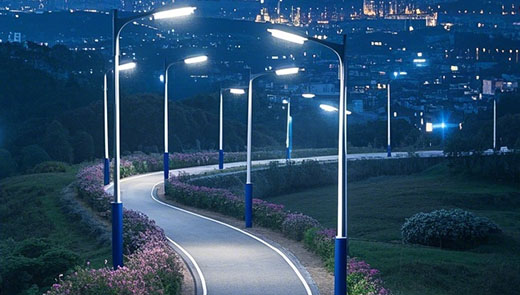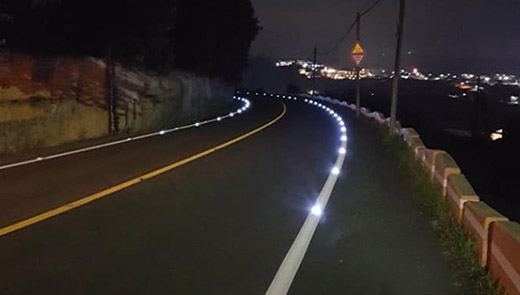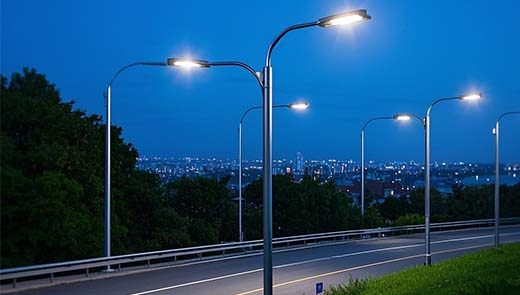Weather and Solar Street Lights Best Practices
Solar led street lights have been widely used around the world due to their outstanding characteristics of environmental protection and energy saving. Many cities have installed solar street lights on municipal roads and rural streets, which not only significantly reduces the consumption of traditional energy, but also reduces carbon emissions by a considerable amount every year. However, different weather conditions have a significant impact on the performance of solar street lights. How do solar street lights perform in all kinds of weather?

Understanding solar street lights and weather Influence
Working Principle of Solar Street Lights
The core component of a solar led street light is a solar panel, or photovoltaic panel. These panels consist of solar cells made from a large number of semiconductor materials, commonly including monocrystalline, polycrystalline and amorphous silicon. When sunlight hits the cell, the energy of the photons is absorbed, exciting electrons out of the atoms and creating electron-hole pairs. Under the action of the electric field inside the battery, the electrons and holes move in opposite directions, respectively, resulting in the formation of an electric current, which realizes the conversion of solar energy to electrical energy. The collected electrical energy is stored in the matching battery for use by the streetlight at night or when there is insufficient light.
The influence of weather on solar led street lights
There are complex interactions between weather and solar led street lights that directly affect the efficiency and functionality of solar power. On a sunny day, the solar panel can absorb a lot of sunlight and realize the best power generation effect, and the output power can reach more than 80% of the rated power. However, on cloudy, rainy or snowy days, the efficiency of solar panels is hindered. Clouds, raindrops and snowflakes scatter and absorb sunlight, resulting in a significant reduction in the effective light intensity reaching the panels and a drop in power generation. Understanding this interaction is critical to overcoming the challenges posed by weather.
Solar led street lights in hot and sunny climates
Challenges
In hot and sunny regions, solar panels are put to a double test over time. On the one hand, the high temperature environment leads to disorganization of electron migration speed inside the panel, increasing resistance and significantly reducing power generation efficiency. After experimental testing, when the panel temperature exceeds 25℃, every 1℃ higher, the power generation efficiency will drop about 0.5%. Take a brand of conventional solar panels as an example, when the ambient temperature reaches 45℃, its power generation efficiency compared to 25℃ dropped by 10%.
On the other hand, continuous exposure to high-intensity UV rays accelerates the aging of the panel encapsulation material, leading to cracking and delamination of the material, which in turn exposes the internal circuitry. This not only reduces the mechanical strength of the panels, making them more susceptible to damage when subjected to external forces, but it also makes them prone to short-circuit failures. This seriously affects the service life and performance of the panels, greatly increasing the cost of maintenance and replacement. According to statistics, the average replacement cycle of solar panels in hot and sunny areas is 2 - 3 years shorter than in mild areas.
How to overcome these challenges?
Prioritize the selection of solar led street lights with high-temperature-resistant characteristics. Solar panels with advanced materials and technologies can significantly improve their adaptability and power generation performance in high-temperature environments. For example, some panels using new nanomaterials can maintain a relatively stable electron mobility under high temperature environment, effectively reducing the increase in electrical resistance, thus reducing the loss of power generation efficiency. Equipping solar led street lights with cooling devices, such as fans or liquid cooling systems, can help maintain the appropriate temperature of the panels and ensure that they are always in optimal working condition. In some large-scale solar led street light projects, the temperature of the panels can be reduced by 10-15C and the power generation efficiency can be increased by about 8% with the use of liquid cooling system.
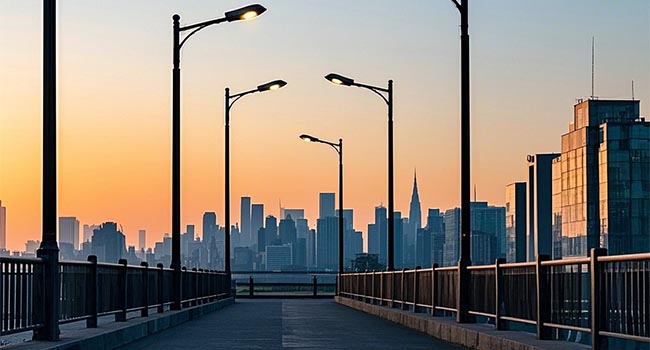
Protective coatings on the surface of the panels not only block UV damage to the panels and extend their service life, but also reflect harmful rays, reduce heat absorption, and reduce the rate of aging. For example, protective coatings containing ultraviolet absorbers can effectively absorb more than 90% of ultraviolet rays, slowing down the aging process of the panel encapsulation material. Regular inspection and maintenance of solar led street lights, timely detection and treatment of fading, cracks and other problems of the battery panel caused by high temperature and strong light. It is recommended to carry out a comprehensive inspection once a quarter and replace the damaged parts in time to ensure the continuous and stable operation of the street light.
Solar street lights in cloudy and rainy climates
Challenges
Under rainy and cloudy weather conditions, light propagation is impeded, the effective light received by solar panels is drastically reduced, and power generation efficiency plummets. Specifically, in cloudy weather, solar panels generate about 30% of the power they would on a sunny day; in light rain, they generate about 20% of the power they would on a sunny day; and in heavy rain, they generate only about 10% of the power they would on a sunny day.
The long-term insufficiency of power generation causes the battery to be in a state of power loss for a long time, and the frequent charging and discharging cycles will easily lead to the sulfation of the battery plate, resulting in the decline of the battery capacity. Take lead-acid batteries as an example, after 15 days of continuous rain, their capacity may drop by 30% - 40%, and eventually over-discharge phenomenon occurs. This not only seriously shortens the service life of the battery, but also causes unstable brightness of street lights, and even can not be lit properly at night, causing great inconvenience to residents traveling.
How to overcome these challenges?
Selection of low-light conditions can still be efficient power generation of solar panels, such as monocrystalline silicon or polycrystalline silicon panels, the conversion efficiency of more than 20%. Meanwhile, panels with anti-reflective coatings or double-sided designs can effectively increase power generation efficiency under cloudy conditions. Bifacial panels can increase power generation by 10% - 20% on cloudy days by capturing light reflected from the ground. Equipped with high-capacity batteries to store more power when the sun is shining and to meet the demand for electricity in cloudy weather. It is recommended to use deep-cycle, high-quality lithium batteries, which have high energy density and a long service life. For example, a certain brand of lithium iron phosphate batteries, cycle life of up to 3000 times or more, can effectively deal with a long period of rainy weather.
Install backup power systems such as wind turbines, small hybrid systems or grid-tied solutions. These back-up power sources ensure continuous lighting of the street lights during extreme weather conditions. In windy areas with frequent rainy days, hybrid energy systems with wind and solar power can improve the stability of the street light supply.
Solar street lights in snowy and cold regions
Challenges
In the cold winter, low temperatures have a significant impact on the physical and chemical properties of solar panels, resulting in an increase in the internal resistance of the panels, a decrease in electron mobility, and a consequent decrease in the amount of power generated. Studies have shown that when the temperature drops to -20℃, the amount of electricity generated by solar panels can drop by 30% - 40%. In addition, after a snowfall, snow will quickly cover the surface of the panel, forming a dense layer of shading, sunlight can not penetrate, the battery can not be charged properly. When the temperature rises and the snow melts, the melted snow water will seep into the interior of the streetlight along the gaps in the battery plates. Street light internal temperature is low, the water is difficult to evaporate, it is very easy to trigger a short circuit. At the same time, the impurities contained in the snow water will have an electrochemical reaction with the metal parts, accelerating the corrosion of the line, seriously damaging the internal components, significantly shortening the service life of the street light.
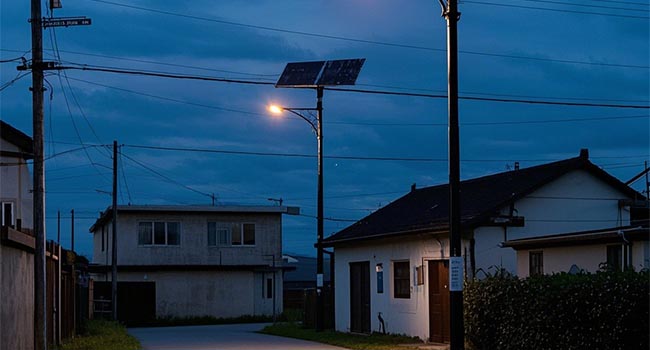
How to overcome these challenges?
Regularly check the solar street light and remove the snow and ice on the battery panel in time. Use a soft cloth or brush for cleaning to avoid scratching the surface of the battery panel. At the same time, reasonably adjust the tilt angle of the battery panel to help the snow slide off naturally. For example, tilting the panels at an angle of 30°-45°can effectively reduce snow buildup. Insulate the battery by wrapping the battery compartment with insulating tape or moving the streetlight indoors during extreme weather to prevent damage to the battery due to low temperatures.
Some street lights with intelligent temperature control systems can automatically adjust the temperature of the battery compartment to ensure that the batteries work in a suitable environment. Ensure that solar street lights have good waterproof performance, and upgrade street lights whose waterproof rating does not meet the requirements to prevent water from entering the interior and causing damage. Sealant and waterproof gasket can be used to seal the street light and improve its waterproof grade.
Solar street lights in windy areas
Challenges
Strong winds pose a multifaceted threat to the safety of solar street lights. Wind energy carries huge kinetic energy, and when blowing towards the street light, it generates strong thrust and torque on the solar panel and lamps. Under the action of continuous strong wind, the bracket that fixes the panel and lamps may be loose, deformed, or even blown down directly. At the same time, the wind wrapped branches, stones and other debris, will be at a high speed impact street lamps, very easy to cause the battery plate rupture, lamp shell damage and other issues. According to statistics, in windy areas, the annual damage rate of street lights caused by strong winds is as high as 10% - 15%. These damages not only cause street lights to fail to work properly, affecting lighting services, but also may cause traffic safety accidents at night, posing a potential threat to pedestrians and vehicles.
How to overcome these challenges?
Installation of reinforced mounting brackets to securely fasten the solar panels and luminaires enhances the stability of the street lights in strong winds, reduces the risk of damage, and ensures continuous operation of the street lights. Use high-strength steel to make the bracket, which can withstand winds of class 12 or above. Installation of windbreaks to change the wind direction reduces the direct impact of strong winds on the solar panels and lamps, reduces the possibility of damage, and extends the service life of the street lights.
For example, in some coastal windy areas, the damage rate of street lights was reduced by about 30% after the installation of deflector-type windbreaks. Regular inspection and maintenance of solar street lights is required to promptly identify and deal with damage and wear and tear caused by strong winds to ensure that the street lights can work properly under various weather conditions. Monthly inspections are recommended to repair loose parts and replace damaged fittings in a timely manner.
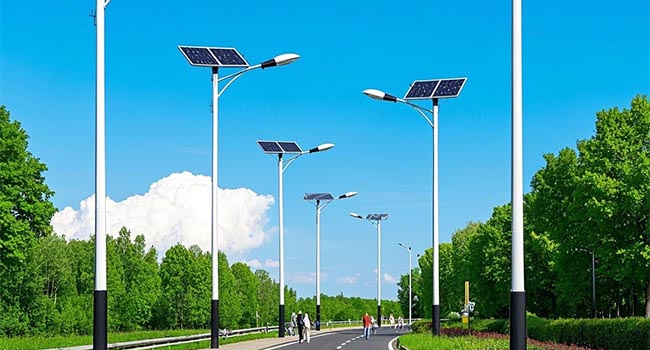
Adaptive lighting technology across weather types
Use of durable materials
In order for solar street lights to adapt to various extreme environments, the use of durable materials such as corrosion-resistant alloys and waterproof coatings is crucial. These materials not only maintain stability in high temperatures, high humidity and polluted urban environments, but also effectively extend the life of the streetlight. For example, the use of stainless steel for street light housings can effectively resist salt spray corrosion and is suitable for coastal areas; while waterproof coatings containing fluorocarbon resins can provide street lights with excellent waterproofing performance and enable them to work normally even in heavy rainfall environments.
Intelligent temperature control system
The built-in temperature control device prevents the streetlight from overheating in high temperature environment and prevents the battery from freezing in cold environment, which ensures that the streetlight can operate efficiently under different temperature conditions. Some high-end solar street lights are equipped with intelligent temperature control system, which can automatically adjust the working status of cooling fan or heating device according to the ambient temperature, so that the battery panel and battery are always in the best working temperature range.
Self-cleaning solar panels
Some solar street lights are equipped with hydrophobic coating and automatic dust removal system, which can automatically remove dust and dirt on the surface of the panel to maintain the power generation efficiency of the panel and reduce the cost of manual maintenance. For example, for panels with nano-scale hydrophobic coating, the contact angle of water droplets on the surface can reach more than 150°, which makes the dust and dirt roll down with the water droplets, effectively keeping the panels clean.
Intelligent dimming and personalized lighting mode
The solar street light can automatically adjust the brightness according to the traffic flow, peak hours and urban demand. For example, a timed dimming mode can be set to keep the brightness high during peak hours and automatically reduce it late at night to save energy. At the same time, different brightness levels can be set for different locations, such as residential areas, highways and public places, to ensure lighting effects and achieve efficient energy use. In residential areas, the street light brightness is reduced by 50% after 12 o'clock at night, which not only meets the basic lighting needs of residents, but also significantly reduces energy consumption.
Different weather conditions bring various challenges to solar street lights, but by choosing the right equipment, taking effective protective measures and carrying out regular maintenance, the performance of solar street lights in various environments can be significantly improved. With the continuous progress of technology, future solar street lights are expected to make greater breakthroughs in adapting to different weather conditions and make greater contributions to the global green lighting cause.

